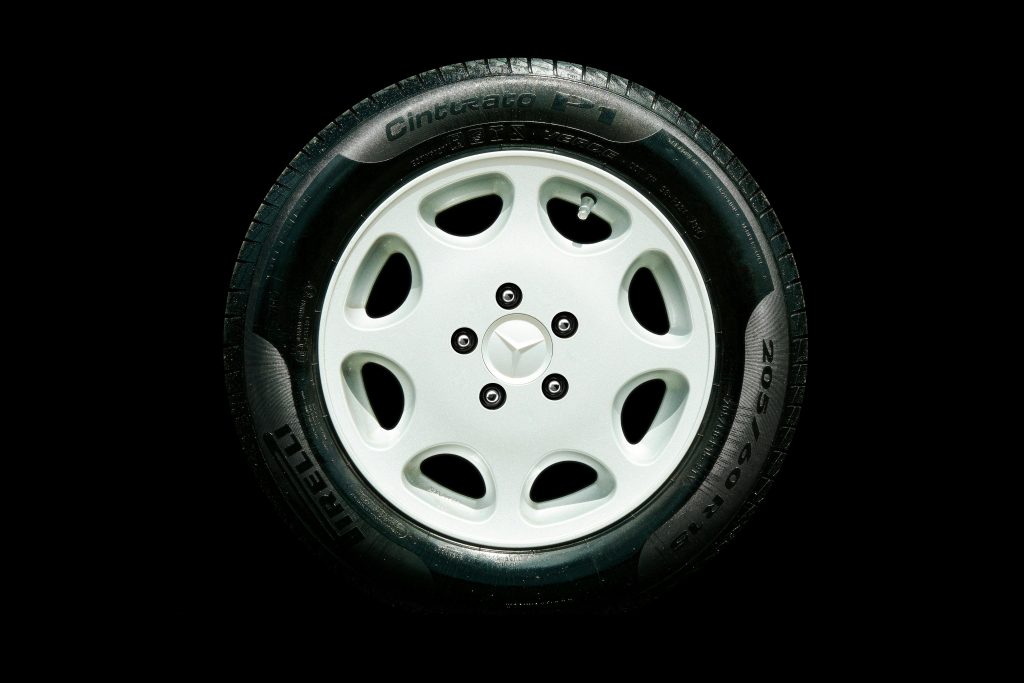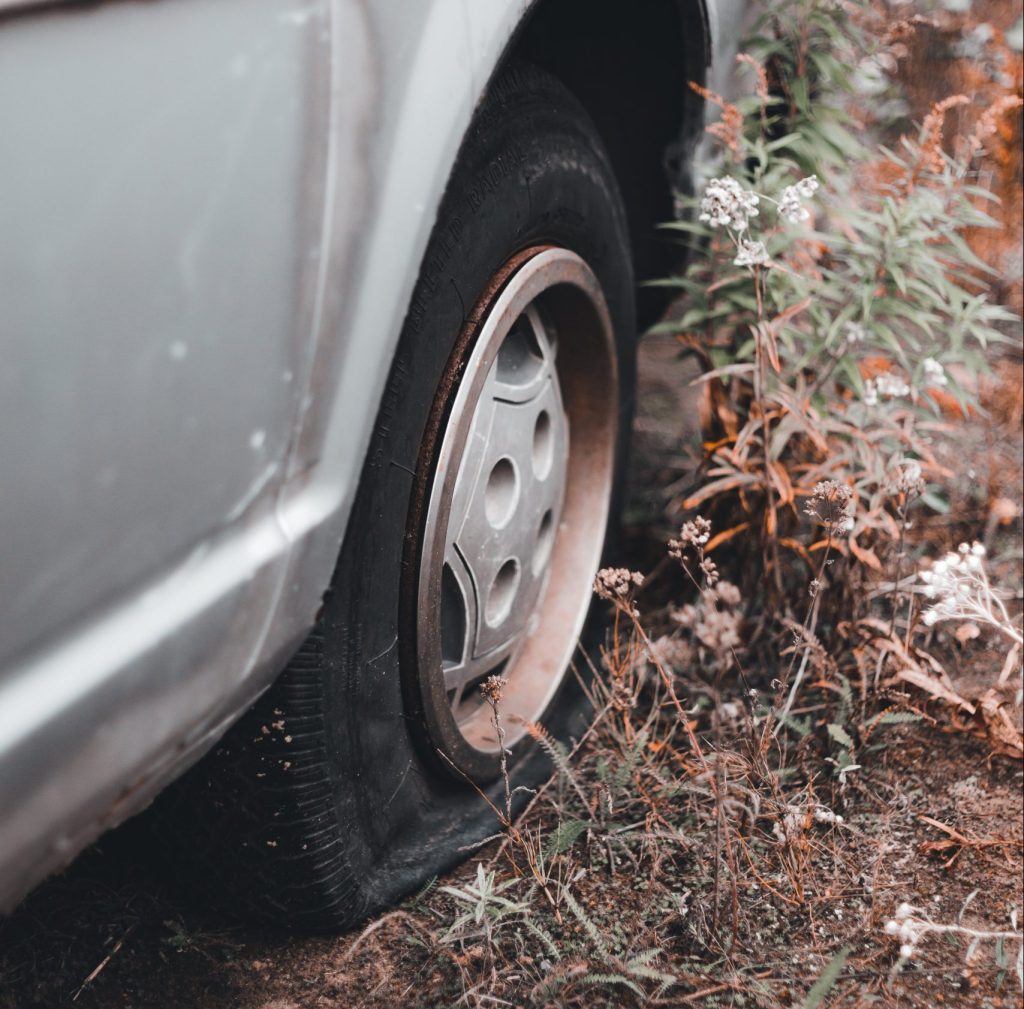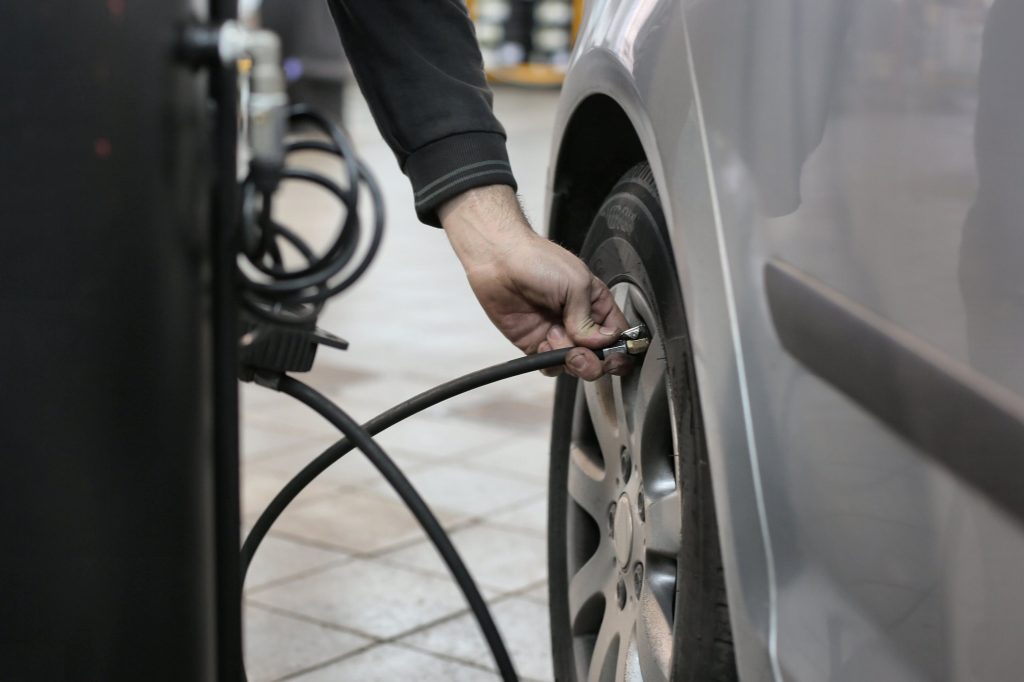Some drivers coast through life without ever getting a flat tyre, while others are seemingly cursed to suffer through the experience all too often. No matter where things stand for you, you need to know what to do if it happens to you. Luckily, we’re here to show you exactly what to do if you get a flat tyre.
In this guide, we’ll take you through the steps you need to take when you notice you’ve got a flat tyre, including how to repair and replace it. We’ll also provide additional advice to help minimise your chances of ending up with a flat tyre.
What to do when you get a flat tyre

If you’ve spotted a flat tyre whilst your car is parked, congratulations! Thank your lucky stars that you weren’t on the move! If this is indeed the case, then you can skip straight ahead to our section on how to change your tyre. If, however, you’re on the move when you realise that you have a flat tyre, it’s important that you take care and really think about your next steps…
How to spot a flat tyre whilst driving
Typically speaking, you’re far more likely to get a flat tyre from a small puncture that results in a steady leak of air—rather than a sudden blowout, which you’d be hard-pressed not to notice. As such, it can sometimes take drivers a few miles or more before they even realise they have a puncture. Now, if one of your tyres is steadily losing air pressure, you’ll start to notice the car pulling to one side (the side the flat tyre is on). You’ll also find it far more difficult to steer and manoeuvre your vehicle.
As you can imagine, this growing lack of control over your vehicle means you need to come to a stop as soon as possible.
Get to safety
Upon realising they have a flat tyre, some drivers attempt to continue slowly moving along the hard shoulder in order to get to the nearest petrol station or stop. This is not an advisable move. As we’ve said, a flat tyre makes it incredibly difficult to control your vehicle—putting you and other road users in unimaginable danger. You should not travel long distances on a flat tyre or at high speeds.
What you need to do instead is find a safe place for you to pull over as soon as you can. If you’re travelling on a dual carriageway or motorway, pull up on the hard shoulder. Take great care and give other road users plenty of notice when manoeuvring your car. If you’re on a minor road, try to pull up in a place where you won’t be much of an obstruction to oncoming traffic.
Listen to the experts

Once you’ve come to a stop, you need to assess if it’s actually safe enough for you to change your tyre. The Highway Code urges drivers only to “change the tyre if you can do so without putting yourself or others at risk—otherwise call a breakdown service.”
Indeed, you should avoid changing your tyre on the hard shoulder of a motorway or at the side of the road, as you might get in the way of oncoming traffic—leading to catastrophic results. Additionally, if you’re driving at night, don’t risk changing a tyre in the dark. Even with a reflective vest, oncoming traffic might find you hard to spot. So, if you’re not entirely sure it’s safe enough for you to change your tyre, call a breakdown service, such as the RAC or the AA. It’s always better to be safe than sorry!
If, on the other hand, you’ve got adequate space and you’re sure you’re not getting in anyone’s way, you’re almost at the stage in which you can change your tyre!
Check you have the right tools
Before you whizz ahead and start moving to change your tyre, you might want to actually check that you’ve got everything you need. After all, changing a tyre is a hefty job and it does require a few important tools.
Tool checklist:
- A spare tyre (duh!)
- A vehicle jack
- Wheel chock(s) to stop your car from rolling as you change the tyre
- Wheel wrench and a wheel nut key (if you have locking nuts)
- Vehicle handbook, which will help you figure out where you’re supposed to attach the jack
- A set of gloves—your wheel will probably be dirty!
Additional items that you might require include a torch—if you need to change your tyre at night—and a reflective jacket to ensure you’re completely visible to oncoming traffic. (Ideally, you should be carrying these essential items in your vehicle anyway!)
Of course, if you don’t have the right tools with you, or you’re in a dangerous place, you shouldn’t attempt to change your tyre. Just call a breakdown service and they’ll tow you to safety and sort out the problem for you.
How to change a flat tyre
1. Stop and prepare your car
Once you’re sure you’ve located a safe place, you need to come to a stop and apply the handbrake. Select first gear (or P, if it’s an automatic car), switch on your hazard lights and turn off the engine. It’s important that you’re on flat ground, as your car will roll if you’re on uneven ground. You then need to remove all passengers from your vehicle and make sure they’re standing a good distance away from the road and vehicle.
If you’re attempting to change your tyre near a busy road, then you might want to put on a reflective jacket to ensure you’re fully visible to oncoming traffic. Additionally, a reflective warning triangle could be beneficial in alerting other road users that there’s a potential hazard or obstruction up ahead.
2. Make sure your car doesn’t roll
For rather obvious reasons, you’ll want to avoid the possibility of your car rolling away when you’re changing its tyre. As such, you’ll want to have your wheel chock(s) at the ready. If you’ve only got one, place it under the wheel that’s diagonally opposite to the one you’re replacing. If you have more than one, feel free to place them under the other wheels just in case.
3. Raise it up
If you haven’t ever changed the tyres on your current vehicle before, then we’d suggest consulting your vehicle’s handbook to find out where the jacking points are. These points differ depending on the vehicle, so be sure to check even if you’ve changed a tyre before. Once you’re absolutely sure where the jacking points are, it’s time to attach your car jack and slowly raise your car until it’s around 10cm above the ground.
4. Start to loosen up
Now it’s time to get your wheel wrench and slowly start to loosen up the wheel nuts—you’ll want to turn them in an anti-clockwise direction. Try to pay attention to how you’re balanced as you’re doing this. If you’re not steady enough, you might end up falling once the wheel nuts give way. Once you’ve removed the wheel nuts, you can then remove the flat tyre.
5. Replace the flat tyre
Once the flat tyre is out of your way, it’s time to attach your new tyre onto the frame. Then, screw the wheel nuts on by hand. Next, lower the jack until the wheels just about touch the ground. You’ll then have to use your wheel wrench to tighten the wheel nuts as much as possible.
6. Put it in the boot
All that’s left for you to do now is put the damaged flat tyre in your boot. You can then choose to get it repaired—if the damage isn’t too great—or dispose of it in the right manner. Don’t forget to take it out of your boot once you’re at home—you don’t want it wasting precious storage space!
Now you know exactly what to do when you get a flat tyre. Of course, if you’d rather avoid the whole kerfuffle, there are a few steps you can take to help minimise your chances of ending up with a flat tyre!
How to avoid getting a flat tyre
Inspect your tyres regularly
Want to know the trick to avoiding a flat tyre? Actually taking the time to check your tyres once in a while (translation: at least once a month). Make your way around each tyre and examine the tyre tread carefully. Check for any kind of abrasions or foreign objects, e.g., nails or miscellaneous debris.
If you do find something, you need to take care when deciding your next step. Taking out a nail, for example, might be the best course of action, as it might prevent the nail from eventually piercing through the tyre. Then again, the nail might be the only thing blocking the hole—leading to a quick deflation. So, if you do remove an object, pay attention and see if any air is escaping. You don’t want to only figure it out once you’re on the motorway, do you?
Check the pressure

Unfortunately, even a weekly inspection of your tyres isn’t enough to help you avoid getting a flat tyre whilst on the move. After all, if a puncture is small enough, you might not see it even when crouching down to look. As such, you might want to invest in a hand-held pressure gauge so that you can see if the tyre’s pressure is at the recommended number listed in your vehicle’s handbook. It doesn’t take long and it could help you save a lot of money and hassle further down the line.
If you do check your tyre pressure, you’ll want to wait until the tyres have cooled down. When you drive, your tyres heat up, which often leads to inaccurate pressure readings.
Get a second opinion
If you’re not entirely sure what you should be looking for, or you suspect your tyres aren’t in the best shape, you might want to take them in to a local garage and have an expert take a look. Though you might be worried about having to fork out more than you’d like to have them replaced, it still might be a better alternative to having your vehicle towed from a motorway because you didn’t bother.
